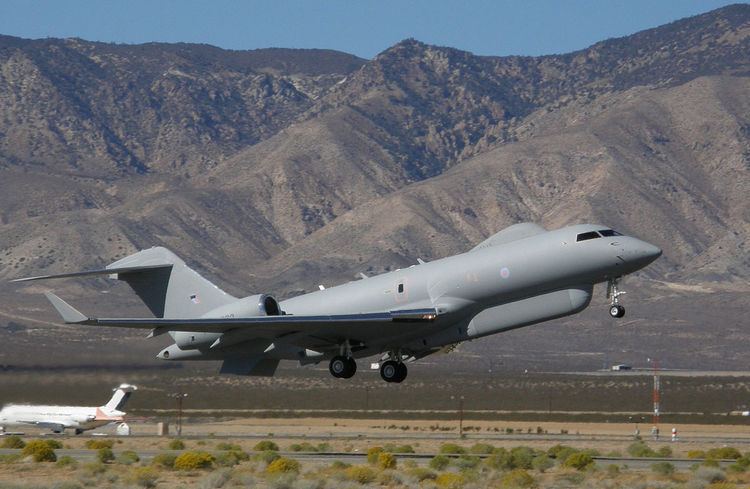Garrison/HQ RAF Waddington | Equipment Raytheon Sentinel | |
 | ||
Active 26 July 1913 – 1947
1949–1957
1959 – 2003
2004 – present Role Ground Reconnaissance (ASTOR) Motto(s) (Latin): Frangas non flectas
("Thou mayst break, but shall not bend me") Battle honours World War I: Mons, Ypres 1915, Loos, Arras, Somme 1918, Amiens
World War II: Arakan 1942–1944, Burma 1944–1945 | ||
No. 5 (Army Co-operation) Squadron often styled V(AC) Squadron of the Royal Air Force is the operator of the Sentinel R1 Airborne STand-Off Radar (ASTOR) aircraft.
Contents
1913—1947
As No. 5 Squadron Royal Flying Corps, it was formed at Farnborough on 26 July 1913, and following the outbreak of the First World War deployed to France on 15 August, equipped with a variety of aircraft types to implement reconnaissance for the British Expeditionary Force (BEF). It flew its first missions on 21 August and on the next day, an Avro 504 of 5 Squadron was the first British aircraft to be shot down, its crew of pilot Second Lieutenant Vincent Waterfall and navigator Lieutenant Charles George Gordon Bayly being killed over Belgium.
No. 5 Squadron standardized on the B.E.2, specializing as observers for artillery, re-equipping with the R.E.8 in May 1917, and working closely with the Canadian Corps, through to the end of the war and into 1919, when it moved into Germany as part of the Army of Occupation. (Its association with the Canadian Corps lead the incorporation of a maple leaf in the squadron's badge when it was approved in June 1937.)
Thereafter in 1920, the squadron was reformed at Quetta, India (now part of Pakistan). There it continued working in Army Air Cooperation for operations on the North West Frontier. From 1920 until 1941 they had a succession of aircraft: Bristol Fighters, Westland Wapitis, Hawker Harts and Hawker Audaxs. In 1942 they received American built Mohawks and became escorts to Blenheim bombers over north west Burma. These were replaced in turn by Hawker Hurricanes and P-47 Thunderbolts. No. 5 Squadron converted to Tempest IIs in February 1946, but disbanded on 1 August 1947.
1949 to date
On 11 February 1949 it reformed at RAF Pembrey in Wales for target-towing duties but in 1951, the squadron moved to Germany to fly the de Havilland Vampire and its successor the de Havilland Venom. The squadron was part of the defence cuts of 1957 but was restored in 1959 as a night fighter squadron at RAF Laarbruch, Germany, first flying the Gloster Meteor NF.11 before re-equipping with the delta winged Gloster Javelin. It moved to RAF Binbrook in 1965 with the English Electric Lightning interceptor keeping these until 1987. From then until 2003, when it was disbanded at RAF Coningsby, No.5 Squadron flew the Panavia Tornado F3 and with this aircraft it was the first RAF squadron (accompanied by No. 29 Squadron) to be deployed as part the UK's contribution to the Gulf War. It reformed on 1 April 2004.
The first production Raytheon Sentinel R.1 made its maiden flight on 26 May 2004. The ASTOR system officially entered service with the No. 5 Squadron on 1 December 2008. Full Operating Capability was expected by the end of 2010. The new radar-equipped aircraft provides battlefield and ground surveillance for the British Army in a similar role to the American Joint Surveillance Target Attack Radar System (JOINT STARS) aircraft.
From 2009, the squadron also operated four Shadow R1 aircraft, based on the Beechcraft King Air 350. These were transferred to 14 Squadron in 2011. 14 Squadron operates as part of 5 Squadron at RAF Waddington.
From September 2014, the squadron has temporarily relocated to Cranwell along with 14 Squadron due to the resurfacing of RAF Waddington's runway which will take over a year to complete.
